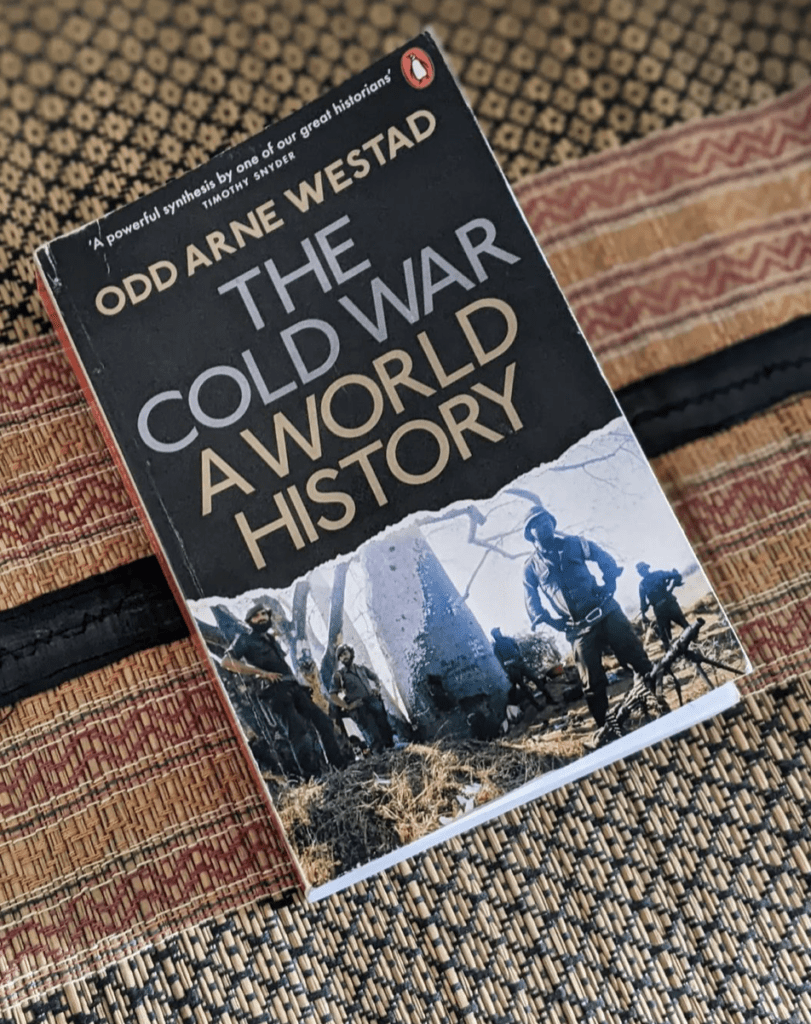Odd Arne Westad
Growing up in the 80s in India, it was impossible not to have experienced the Cold War in some way – from listening to adults discussing it to having USA vs USSR wrestling matches between us kids! So this was nostalgia to some extent. And even though not by design, this was an opportune time to read this. To understand the direction and extent of the US hegemony in the last three decades and its impact on contemporary geopolitics, and to read it at the specific time when the Russian military invasion of Ukraine is bringing out a world order that is not just US-centric.
The Cold War is about not just about philosophy and politics, but people, places and the events that were either cause or effect. Ideologically, it was a contest of how the world and its citizens should be organised and into that whirlpool a lot of countries, policies and people were sucked. And in the end, as Depeche Mode sang, “The dawning of another year…one in four still here”.
It is interesting to note that this level of bipolar conflicts are quite rare in world history, barring say Spain’s Catholicism vs English Protestantism. Though the Cold War can be seen as a confrontation between capitalism and socialism from 1945 to 1989, its roots exist even before World War 1. And its impact can be seen in contemporary politics – from the state of Afghanistan to authoritarian China to unhinged North Korea.
Socialism as a thought had existed since the French Revolution but its acceleration and the start of the Cold War happened in the context of two processes – the emergence of new states (50 in 1900 to 200 by the end of the century) and the transfer of power to the United States during the world wars. This combined with the Russian Revolution of 1917 and the creation of the Soviet state as an alternate to the US brand of capitalism set the stage. The socialists considered the war a creation of capitalism and saw it as a war between robbers and thieves who had nothing in common with the soldiers fighting the war. The only thing that could benefit the common man was socialism and communism. Lenin set up Comintern in 1919 to which a bunch of nationalists and anti colonialists flocked. Towards the end of WW2, Churchill used “an iron curtain” despite the Soviets being an ally.
And thus began the tussle that saw historic personality clashes and alliances – FDR, Stalin, Churchill, Truman, Eisenhower, Kennedy, Brezhnev, Johnson, Khrushchev, Nixon, Ford, Carter, Reagan, Gorbachev as well as Latin American, East European and African dictators, Chinese autocrats, South Asian, Middle Eastern and “non aligned” leaders like Nehru and Sukarno. Not to mention China playing the superpowers and sometimes getting played. The Cold War had places as far away as Berlin, Brazil, Baghdad and Busan all becoming a theatre of war. When one looks at the dictatorships that the US propped up in Latin America, it is easy to wonder whether it’s really different from what the USSR did in Eastern Europe. The book also takes us through the context in which organisations like the UN, IMF and NATO were formed and how they became the arenas of the Cold War. Multiple spurts of arms races, events such as the Korean, Vietnam and Afghanistan wars, the Suez Canal clash, Cuban missile crisis, and even an ‘internal’ event like Watergate all left their mark.
It is fascinating to think about how the world might have been different if Gorbachev had decided not to take his annual vacation in Crimea in August 1991. Would there have been a coup at all, or would he have been able to put it down and steer the Soviet into a democratic coalition of independent republics? Would they have been part of the EU now? Would there be Putin, or even Donald Trump? Odd Arne Westad does a great job of making this narrative of contemporary history accessible and engaging. It is not an easy task to map time, places and people and cover everything that deserves a spot, but he does a fabulous job. if you’re even slightly interested in history, this should be in your reading list.
Side Notes
1. Denmark in 1899 was the first country to have an agreement of annual negotiations over wages and working conditions. Probably explains its quality of life now.
2. Capitalist Norway has more state ownership of companies than China
3. Hilarious Soviet Russia jokes on pg 368, 535
4. Romania was so poverty-stricken that when Ceausescu visited Queen Elizabeth in 1978, the palace staff removed all valuables from guest rooms because he and his wife Elena might take them back with them!
5. One does feel sad for Gorbachev and how under-appreciated he was by his own people. For a Communist leader, Glasnost and perestroika were extremely liberal initiatives with the good intent of providing more freedom and a better quality of life for the people of USSR
6. An entire chapter is devoted to Indira Gandhi and boy, she was strong! In intent, speech, and action. To stand up to the might of the US when surrounded by Pakistan and China is no mean feat. “My father was a statesman, I am a political woman. My father was a saint. I am not.”

